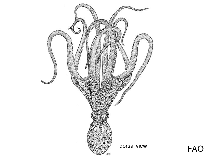Octopus mimus Gould, 1852
Changos octopus
Classification / Names Populärnamn | synonymer | CoL | ITIS | WoRMS
Cephalopoda | Octopoda | Octopodidae
Environment: milieu / climate zone / djupintervall / distribution range Ekologi
; djupintervall 0 - 30 m (Ref. 96968). Temperate; 3°S - 33°S, 82°W - 70°W (Ref. 106951)
Distribution Länder | FAO områden | Ekosystem | Förekomster | Utplanteringar
Southeast Pacific: Peru and Chile. Subtropical to temperate.
Length at first maturity / Size / Weight / Age
Könsmognad: Lm ? range ? - ? cm Max length : 19.0 cm ML hane/ej könsbestämd; (Ref. 96968); publicerad maxvikt: 4.0 kg (Ref. 96968)
Life cycle and mating behavior Könsmognad | Reproduktion | Lek | Eggs | Fecundity | Larvae
Main reference
referenser | Koordinator | Medarbetare
Thatje, S., O. Heilmayer and J. Laudien 2008 Climate variability and El Niño Southern Oscillation: implications for natural coastal resources management. Helgol Mar Res 62(Suppl1):S5-S14. (Ref. 92479)
IUCN Red List Status
(Ref. 130435: Version 2025-1)
CITES status (Ref. 108899)
CMS (Ref. 116361)
Threat to humans
Human uses
| FishSource |
Verktyg
Ytterligare information
Max. ages / sizes
Length-weight rel.
Length-length rel.
Length-frequencies
Mass conversion
Abundans
Internet-källor
BHL | BOLD Systems | CISTI | DiscoverLife | FAO(Publication : search) | Fishipedia | GenBank (genome, nucleotide) | GloBI | Gomexsi | Google Books | Google Scholar | Google | PubMed | Tree of Life | Wikipedia (Go, sök) | Zoological Record



